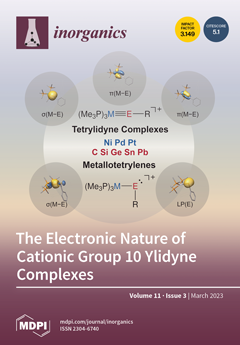We report a broad theoretical study on [(PMe
3)
3MER]
+ complexes, with M = Ni, Pd, Pt, E = C, Si, Ge, Sn, Pb, and R = Ar
Mes, Tbb, (Ar
Mes = 2,6-dimesitylphenyl; Tbb = C
6H
[...] Read more.
We report a broad theoretical study on [(PMe
3)
3MER]
+ complexes, with M = Ni, Pd, Pt, E = C, Si, Ge, Sn, Pb, and R = Ar
Mes, Tbb, (Ar
Mes = 2,6-dimesitylphenyl; Tbb = C
6H
2-2,6-[CH(SiMe
3)
2]
2-4-
tBu). A few years ago, our group succeeded in obtaining heavier homologues of cationic group 10 carbyne complexes via halide abstraction of the tetrylidene complexes [(PMe
3)
3M=E(X)R] (X = Cl, Br) using a halide scavenger. The electronic structure and the M-E bonds of the [(PMe
3)
3MER]
+ complexes were analyzed utilizing quantum-chemical tools, such as the Pipek–Mezey orbital localization method, the energy decomposition analysis (EDA), and the extended-transition state method with natural orbitals of chemical valence (ETS-NOCV). The carbyne, silylidyne complexes, and the germylidyne complex [(PMe
3)
3NiGeAr
Mes]
+ are suggested to be tetrylidyne complexes featuring donor–acceptor metal tetrel triple bonds, which are composed of two strong π(M→E) and one weaker σ(E→M) interaction. In comparison, the complexes with M = Pd, Pt; E = Sn, Pb; and R = Ar
Mes are best described as metallotetrylenes and exhibit considerable M−E−C bending, a strong σ(M→E) bond, weakened M−E π-components, and lone pair density at the tetrel atoms. Furthermore, bond cleavage energy (
BCE) and bond dissociation energy (
BDE) reveal preferred splitting into [M(PMe
3)
3]
+ and [ER] fragments for most complex cations in the range of 293.3–618.3 kJ·mol
−1 and 230.4–461.6 kJ·mol
−1, respectively. Finally, an extensive study of the potential energy hypersurface varying the M−E−C angle indicates the presence of isomers with M−E−C bond angles of around 95°. Interestingly, these isomers are energetically favored for M = Pd, Pt; E = Sn, Pb; and R = Ar
Mes over the less-bent structures by 13–29 kJ·mol
−1.
Full article





